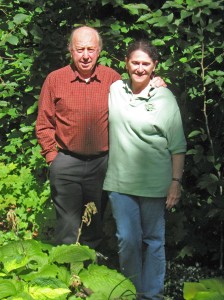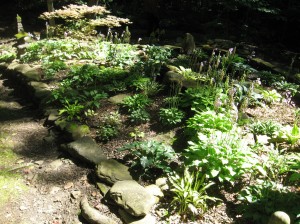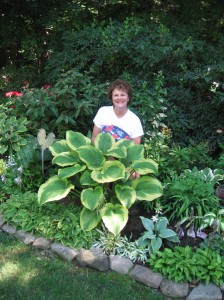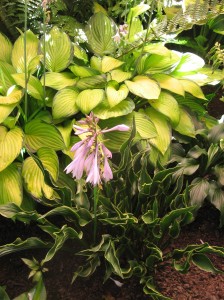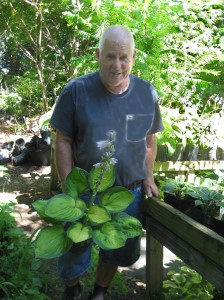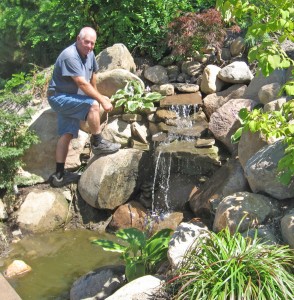By Mary Ruth Smith
Photographs by Brent Smith
Is there any such thing as too many hostas? Not according to the hosta enthusiasts I recently visited in the Buffalo and Dunkirk areas. Mike and Kathy Shadrack, Marcia Sully, and Ran Lydell are active members and officers of the Western New York Hosta Society, hereinafter referred to as the WNYHS. I wanted to find out why hostas are so popular and seem to be especially so in this part of the country. They eagerly shared their knowledge with me and showed me their amazing gardens showcasing this versatile plant.
Mike and Kathy live outside Hamburg on thirteen acres with a beautiful shale-lined creek tumbling down the hillside and under their house. Mike is British and spent thirty-two years as a London policeman. He got interested in hostas when he planted a few around a fish pond, fish being his primary hobby at the time. That led to an association with the British Hosta Society and meeting and marrying American hosta enthusiast Kathy Guest, who brought him to upstate New York. You never know what might happen when you start collecting hostas! Now he’s known as the Hosta Man, both here and in the UK where he is the hosta expert for an English grower.
Kathy was one of the founding members of the WNYHS, but she grows other perennials as well and is active in their societies. Together they have landscaped and planted their Smug Creek Garden, named after the creek that runs through it, and now have about 600 varieties of hosta of all shapes, colors, and sizes. Kathy recently wrote The Book of Little Hostas for Timber Press in which she shares her expertise growing miniatures, one of the hot trends in hostas today. Mike has also authored and photographed books on hostas and together they present programs for clubs and garden symposia.
Hostas have come a long way since there were only two options, green or green-and-white, and were known as “cemetery plants.” I remember them from many years ago lining driveways and sidewalks in my hometown in Illinois, where they were known as “funkia,” and a more boring plant would be hard to find. Now there are about seven thousand named varieties, thirty-five hundred of which are registered with the American Hosta Society, which keeps the official database of plant names. It’s impossible to say how many of them are available in commerce; enthusiasts like the Shadracks, who have hybridized several, are creating more all the time. Kathy has registered three and Mike one.
Hostas are now a top-selling perennial. The Shadracks say it’s because they have good foliage all season, a nice architectural form and are easy to grow. Kathy says she tells people,” Dig a hole, drop it in, and get out of the way.”
Kathy grows many miniatures, her specialty, in pots on her deck and in the garden where they can be elevated for better viewing. They also have a shady rock garden devoted to small hostas. She likes them because they are collectible and cute and make a great addition to today’s popular fairy gardens. She suggests collecting them by “dynasties,” a dynasty being a family of hostas all descended from an original variety. For instance, the wildly popular ‘Blue Mouse Ears’ now has about twenty mousy derivatives. Dynasties are possible because hostas have a tendency to “sport,” which happens when a mutation causes one leaf to be different from the parent plant. That offshoot with the new leaf pattern then becomes a new variety and may also sport to produce the next generation.
A few miles away in Eden, Marcia Sully and her husband David have been gardening for 43 years on a two-acre property they call “The Hidden Gardens of Eden.” She grew her first hostas in the ‘90s to hide an ugly foundation and became hooked. She calls herself a “certified hosta-holic,” with over 1000 varieties in her garden. For someone with no formal horticulture or design training, she shows an amazing grasp of design principles. Her beds are beautifully laid out to show the plants at their most attractive. She spends as much time planning as planting and makes careful measurements before laying out the beds so that each plant has room to shine. She hides little hostas under and behind big ones to promote what she calls the “Mystique of the Hidden Garden.”
Sully has been an amateur hybridizer for several years and finally, this year, is going to register her first five varieties. They are named after her two daughters and her granddaughter. Her favorite hostas are the large ‘Leading Lady’ and medium-sized ‘Allegan Fog’. She grows many other perennials as companion plants to her hostas and in sunny beds in her front yard.
Ran Lydell and his wife Katy have operated Eagle Bay Gardens in Dunkirk for 38 years. The eight-acre nursery specializes in rare and unusual plants, and he hybridizes Japanese maples and daylilies as well as hostas. Several ponds and lagoons are linked by bridges and encourage exploring to find the tropical island and the “desert.”
Ran’s introduction to hosta collecting came many years ago when he had a client with a spot where “nothing would grow.” He tried hostas there and they worked, so he started using them more in his landscaping work and in his own garden, always looking for something new and unusual. He remembers how excited he was when he saw his first yellow hosta and how amazing it was to have thirty varieties. He has no idea how many he has now, but they cover several growing fields, and he has introduced into commerce about forty-five of his hybrids, a large selection of which are available at his nursery
Trends in new hostas include plants with red stems, ruffled edges, and fragrance. He is concentrating on improving the beauty of the flowers in his hybrids. Up until now all hosta flowers have been lavender or white, but who knows what may happen? Many gardeners find the flowers unappealing and cut off the stems as soon as they appear. It would be great to have the added bonus of beautiful and fragrant flowers.
He attributes the popularity of hostas to their ease of growing. Gardeners find that they can be successful and want more and more of them. He says, “If you can’t grow hostas, give up gardening and take up golf.”
While some new and rare varieties can fetch hundreds of dollars at plant auctions, there are plenty available at prices the average gardener can afford. This is due largely to their ease of propagation. They are known as “the Friendship Plants,” because they are so easy to share. Ran was reluctant to name a favorite but conceded that ‘Emerald Ruff Cut’ was one.
The Eagle Bay Garden property was once home to a sawmill and there are ruins of its old foundation on the property. Ran is planning to make a tropical garden with palm trees in the shelter of the old stone walls. When someone tells him “You can’t grow that here,” he takes it as a challenge and finds a way to do it.
One challenge for serious hosta collectors is the availability of plants. A good local nursery like Ran’s is a place to start, and there are many sources on the Internet. These gardeners have acquired many of their rare hostas at the plant auctions held at local, regional, and national meetings of the WNYHS. If you want to learn more about hostas and connect with other enthusiasts, check out also the Genesee Valley Hosta Society in the Rochester area, and Upstate Hosta Society in the Syracuse and Ithaca area.
A final note: Hostas are addictive. Don’t say I didn’t warn you!
A Hosta-Growing Primer
Hostas are shade-tolerant, but not shade loving. They will grow, but not thrive, in deep shade. Blue hostas require shade, green and variegated ones tolerate sun, and gold ones love sun. They love our climate, with plenty of rain, and good snow cover to protect them in winter. They seldom need watering; Marcia never waters the ones she plants in the ground. Potted hostas will obviously need more water. A scattering of fertilizer in the spring is all they need, unless you want giants.
Deer and slugs can be a problem. The Shadracks have deer fencing and also spray with Liquid Fence. Marcia scatters Milorganite over her beds and paths in the early spring to deter the deer. A scattering of slug bait over the ground in spring and repeated every two weeks helps kill slugs and snails. If you have pets, be sure to get a pet-safe product.
There is a hosta virus that causes the leaves to have a mottled appearance. Be careful to buy plants from reputable nurseries, as the virus may spread to the other hostas in your garden and could eventually kill them.
If You Go
Mike and Kathy Shadrack live on Zimmerman Road in Hamburg. Their excellent website, smugcreekgardens.com tells all about them, their books and programs, and has many of Mike’s photographs of the garden. Their garden is open to visitors on Thursdays and Fridays in July as part of the Buffalo Open Gardens scheme, and they are part of the National Garden Walk in Buffalo the last weekend in July—worth noting for next year. Individuals and groups can visit the garden at other times by appointment.
Marcia Sully’s garden is also open on Thursdays and Fridays in July as part of Buffalo Open Gardens. She welcomes visitors at other times by appointment. Her phone number is 716-992 4994.
Ran Lydell’s garden and nursery, Eagle Bay Gardens, is located on Rt. 20, east of Dunkirk. Call ahead to be sure it’s open, as he and his wife operate it by themselves. The phone number is 716-792-7581.
More:
Another hosta specialty garden to visit is also in the southtowns. Jerry Murray and his wife Ruth started Murray Brothers Nurseries about 50 years ago on the corner of Rte 20A and Transit Road, in Orchard Park, and live just down the road. In his own garden, Jerry enjoyed specializing at first in ferns and irises before discovering he had the perfect conditions for hostas—lots of dappled shade in a very large area surrounded by native birch trees. Today, twenty years later, Murray’s Hosta Gardens, now a small specialty nursery, attracts gardeners to look, ask questions, seek help, and select from the 300 varieties of hostas grown there.
A long-time member of the WNYHS, Murray hybridized ‘Whirl Away’, similar to ‘Whirlwind’ but with more white variation and more pronounced twist to the leaves.
Among his favorites are ‘Stained Glass’ for its color, ‘Sum and Substance’ for its large size, and ‘Halcyon’, one of the bluest of the blue hostas.
The Murray Hosta Gardens, located at 4735 Transit Rd., Orchard Park, are open every day except Tuesdays from 10:30 am –4 pm. Murray can be reached at 716-662 3860.
Views: 46



